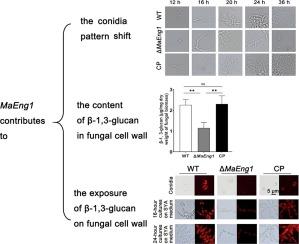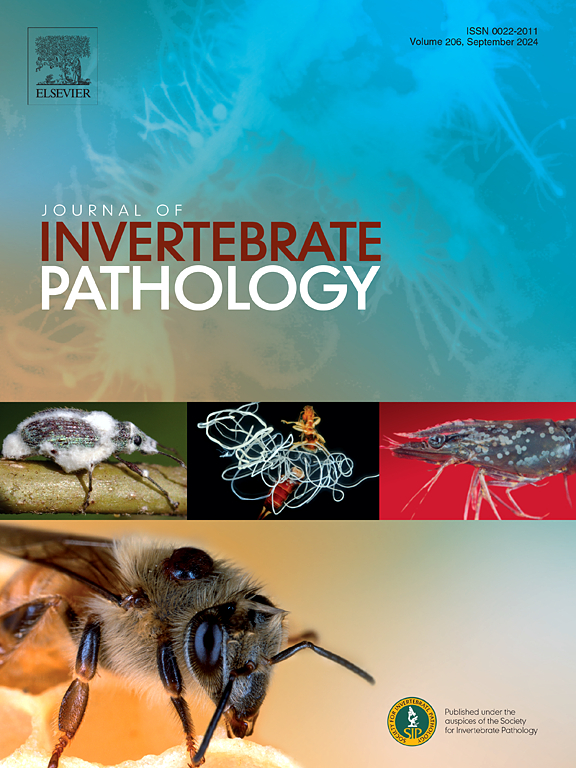MaEng1, an endo-1,3-glucanase, contributes to the conidiation pattern shift through changing the cell wall structure in Metarhizium acridum
IF 3.6
3区 生物学
Q1 ZOOLOGY
引用次数: 0
Abstract
Microcycle conidiation has displayed the greater potential than normal conidiation in large-scale production of mycopesticides. Fungi require partial hydrolysis of the cell wall to achieve the necessary plasticity during their morphological changes. Therefore, various cell wall-associated hydrolases are crucial for fungal morphogenesis. Eng1, as an endo-β-1,3-glucanase, is involved in the cell separation of fungi, but its role in morphological changes of entomopathogenic fungi is not yet clear. Here, the endo-β-1,3-glucanase gene MaEng1 was characterized in the model entomopathogenic fungi M. acridum. MaEng1 possesses a typical carbohydrate hydrolase domain and belongs to the GH81 family. The functions of MaEng1 in fungal growth, stress tolerance, pathogenicity, and conidiation capacity were analyzed using targeted gene disruption. The results displayed that the absence of MaEng1 does not affect the fungal growth, stress tolerances, and pathogenicity in M. acridum. However, the knockout of MaEng1 led to the normal conidiation of M. acridum on the SYA medium, which can induce the microcycle conidiation. Moreover, the content of β-1,3-glucan in the cell wall of the MaEng1-disruption strain were significantly reduced and the exposures of β-1,3-glucan on the surface of the mature conidia and mycelia in ΔMaEng1 were declined, indicating that MaEng1 contributes to the conversion of conidiation mode in M. acridum by affecting the cell wall structure.

MaEng1是一种内-1,3-葡聚糖酶,它通过改变梭菌的细胞壁结构促进分生模式的转变。
在大规模生产杀菌剂方面,微周期分生比普通分生具有更大的潜力。真菌在形态变化过程中需要部分水解细胞壁,以实现必要的可塑性。因此,各种细胞壁相关水解酶对真菌的形态发生至关重要。Eng1 作为一种内-β-1,3-葡聚糖酶,参与真菌的细胞分离,但其在昆虫病原真菌形态变化中的作用尚不明确。本文研究了昆虫病原真菌M. acridum的内-β-1,3-葡聚糖酶基因MaEng1。MaEng1 具有典型的碳水化合物水解酶结构域,属于 GH81 家族。研究人员利用靶向基因干扰技术分析了MaEng1在真菌生长、抗逆性、致病性和分生能力方面的功能。结果表明,缺失 MaEng1 不会影响吖啶霉的真菌生长、胁迫耐受性和致病性。然而,敲除 MaEng1 后,尖吻蘑菇在 SYA 培养基上正常分生,并能诱导微循环分生。此外,MaEng1基因敲除菌株细胞壁中的β-1,3-葡聚糖含量明显降低,ΔMaEng1基因敲除菌株成熟分生孢子和菌丝表面的β-1,3-葡聚糖暴露量减少,表明MaEng1通过影响细胞壁结构促进了刺吸木霉菌分生模式的转换。
本文章由计算机程序翻译,如有差异,请以英文原文为准。
求助全文
约1分钟内获得全文
求助全文
来源期刊
CiteScore
6.10
自引率
5.90%
发文量
94
审稿时长
1 months
期刊介绍:
The Journal of Invertebrate Pathology presents original research articles and notes on the induction and pathogenesis of diseases of invertebrates, including the suppression of diseases in beneficial species, and the use of diseases in controlling undesirable species. In addition, the journal publishes the results of physiological, morphological, genetic, immunological and ecological studies as related to the etiologic agents of diseases of invertebrates.
The Journal of Invertebrate Pathology is the adopted journal of the Society for Invertebrate Pathology, and is available to SIP members at a special reduced price.

 求助内容:
求助内容: 应助结果提醒方式:
应助结果提醒方式:


